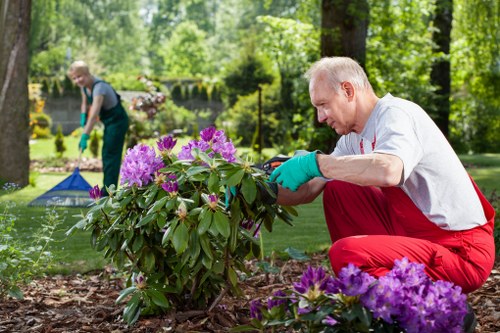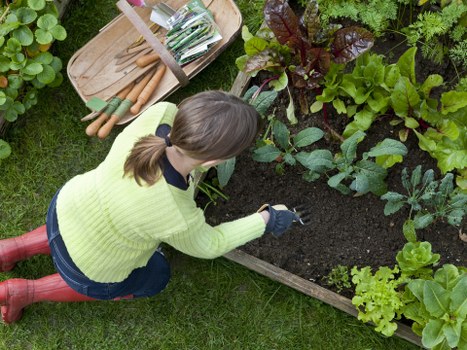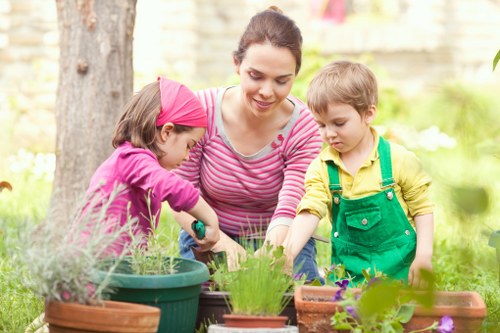Enhance Your Outdoor Space with Quality Garden Fencing

Introduction to Garden Fencing
Garden fencing is a crucial element in defining the boundaries of your outdoor space, providing both functionality and aesthetic appeal. Whether you're looking to create a private sanctuary, protect your plants, or simply add a decorative touch to your garden, choosing the right fencing can make a significant difference.
There are numerous types of garden fencing available, each offering unique benefits and styles. From traditional wooden panels to modern metal designs, the options are vast and versatile. Understanding the various materials and styles will help you make an informed decision that best suits your garden’s needs and your personal taste.
In this comprehensive guide, we will explore the different aspects of garden fencing, including types, materials, installation tips, maintenance, and design ideas. Whether you're a seasoned gardener or a homeowner looking to enhance your outdoor space, this article will provide valuable insights to help you choose the perfect fence for your garden.

Types of Garden Fencing
Choosing the right type of garden fencing depends on various factors, including the desired level of privacy, the garden's purpose, and the overall aesthetic you aim to achieve. Here are some of the most popular types of garden fencing:
Wooden Fencing
Wooden fences are a timeless choice, offering a classic look that complements any garden style. They are versatile and can be customized in terms of height, color, and design.
Advantages of Wooden Fencing
- Natural Appearance: Blends seamlessly with garden landscapes.
- Customizable: Can be painted, stained, or left natural.
- Durable: With proper maintenance, wooden fences can last for many years.
Metal Fencing
Metal fences, including wrought iron and aluminum, provide a sturdy and elegant solution. They are ideal for adding a touch of sophistication and security to your garden.
Advantages of Metal Fencing
- Strength: Offers high durability and security.
- Low Maintenance: Resistant to pests and weather damage.
- Variety: Available in numerous styles and finishes.
Vinyl Fencing
Vinyl fencing is a modern alternative to traditional materials, offering a clean and maintenance-free option. It comes in various colors and styles, making it a popular choice for contemporary gardens.
Advantages of Vinyl Fencing
- Low Maintenance: Requires only occasional cleaning.
- Durable: Resistant to rot, pests, and weather extremes.
- Variety: Available in multiple styles and colors.

Materials Used in Garden Fencing
The material you choose for your garden fence plays a significant role in its appearance, durability, and maintenance requirements. Here are some common materials used in garden fencing:
Wood
Wood is a popular choice due to its natural beauty and versatility. Common types include cedar, pine, and spruce, each offering different characteristics and benefits.
Pros and Cons of Wood
- Pros: Aesthetic appeal, customizable, renewable resource.
- Cons: Requires regular maintenance, susceptible to rot and pests.
Metal
Metal fences, such as those made from iron, steel, or aluminum, are known for their strength and longevity. They are often used for security purposes as well as decorative accents.
Pros and Cons of Metal
- Pros: Highly durable, low maintenance, elegant designs.
- Cons: Can be prone to rust if not properly treated, higher initial cost.
Vinyl
Vinyl fencing is engineered from PVC, offering a sleek and modern look. It is an excellent option for those seeking a hassle-free fencing solution.
Pros and Cons of Vinyl
- Pros: Low maintenance, resistant to weather and pests, available in various styles.
- Cons: Limited color options compared to wood, can be more expensive upfront.
Composite
Composite fencing combines wood fibers and plastic, providing the look of wood with enhanced durability. It is an eco-friendly option that requires minimal upkeep.
Pros and Cons of Composite
- Pros: Resistant to rot and insects, low maintenance, environmentally friendly.
- Cons: Can be more expensive than traditional wood, limited color choices.

Installation Tips for Garden Fencing
Proper installation is key to ensuring the longevity and functionality of your garden fence. Here are some essential tips to consider during the installation process:
Planning and Measuring
Before installing your fence, carefully plan its layout and measure the area to determine the materials needed. Consider the height, style, and type of fence that best suits your garden's requirements.
Steps for Accurate Measurement
- Mark the Boundary: Clearly define the perimeter where the fence will be installed.
- Measure Twice: Ensure all measurements are accurate to avoid material wastage.
- Account for Gates: Plan the placement of any gates or entry points.
Preparing the Ground
A properly prepared foundation is crucial for a stable fence. This involves clearing the area, leveling the ground, and setting sturdy posts.
Ground Preparation Steps
- Clear the Area: Remove any debris, rocks, or vegetation from the installation zone.
- Level the Ground: Ensure the area is even to provide a stable base for the fence.
- Set Secure Posts: Dig holes for fence posts and secure them with concrete for added stability.
Assembling the Fence
Following the manufacturer’s instructions is essential for proper assembly. Take your time to ensure each section is securely attached and aligned.
Assembly Tips
- Use Quality Fasteners: Opt for screws or nails that are appropriate for the chosen material.
- Check for Level: Use a level to ensure each panel is straight and even.
- Secure Gates Properly: Ensure gates are aligned and function smoothly.
Finishing Touches
Once the fence is assembled, add any finishing touches such as painting, staining, or adding decorative elements to enhance its appearance.
Enhancing Aesthetics
- Paint or Stain: Protect your fence from the elements while adding color.
- Add Decorative Panels: Incorporate designs or patterns for a unique look.
- Install Lighting: Illuminate your fence to create ambiance and improve visibility.

Maintenance and Care for Garden Fencing
Regular maintenance is essential to keep your garden fence looking its best and functioning effectively. The maintenance requirements vary depending on the material used.
Wooden Fencing Maintenance
Wooden fences require periodic treatment to prevent rot, warping, and pest infestations. Regular inspections and timely repairs can extend the life of your wooden fence.
Maintenance Tips for Wood
- Seal or Stain: Apply a protective sealant or stain annually to shield against moisture.
- Inspect for Damage: Check for loose boards, nails, or signs of rot.
- Replace Damaged Sections: Promptly repair or replace any compromised parts.
Metal Fencing Maintenance
Metal fences are generally low maintenance but still benefit from regular care to prevent rust and corrosion.
Maintenance Tips for Metal
- Clean Regularly: Remove dirt and debris to maintain appearance.
- Apply Protective Coating: Use anti-rust paint or treatments as needed.
- Check for Loose Parts: Tighten any bolts or screws that may have loosened over time.
Vinyl Fencing Maintenance
Vinyl fences are renowned for their minimal maintenance needs. Occasional cleaning is typically sufficient to keep them looking new.
Maintenance Tips for Vinyl
- Wash Regularly: Use a hose with mild detergent to remove dirt and grime.
- Inspect for Damage: Look for cracks or breaks and replace damaged sections promptly.
- Avoid Harsh Chemicals: Use gentle cleaning agents to prevent discoloration.
Composite Fencing Maintenance
Composite fences combine the best of wood and vinyl, offering durability with a natural appearance. They require minimal maintenance to stay in top condition.
Maintenance Tips for Composite
- Clean Periodically: Use a soft brush and mild soap to clean the surface.
- Inspect for Damage: Check for any signs of wear or impact damage.
- Avoid Excessive Pressure: Prevent dents by avoiding heavy impacts.
Design Ideas for Garden Fencing
Your garden fence can significantly enhance the overall design of your outdoor space. Here are some creative ideas to inspire your garden fencing project:
Decorative Panels
Incorporate decorative patterns or motifs into your fence panels to add visual interest and personalization.
Ideas for Decorative Panels
- Laser-Cut Designs: Intricate patterns cut into metal or wood panels.
- Lattice Inserts: Classic grid patterns that can also support climbing plants.
- Color Accents: Use contrasting colors to highlight certain sections.
Incorporating Plants
Use your fence as a support structure for climbing plants like vines, roses, or ivy. This not only enhances the beauty of the fence but also provides natural privacy.
Planting Ideas
- Climbing Vines: Plants like wisteria or clematis add elegance.
- Flowering Plants: Roses and sweet peas for vibrant colors.
- Herbs and Vegetables: Functional plants that can be harvested.
Integrated Lighting
Adding lighting to your garden fence can create a magical ambiance during the evening hours. Options include string lights, solar-powered fixtures, or LED strips.
Lighting Ideas
- Solar Lights: Eco-friendly and easy to install.
- String Lights: Create a cozy and inviting atmosphere.
- Spotlights: Highlight specific sections or decorative elements.
Color and Finishes
Choosing the right color or finish for your fence can enhance the overall look of your garden. Consider matching the fence color to your home's exterior or opting for a bold hue to make a statement.
Color Ideas
- Classic White: Timeless and versatile.
- Natural Wood Stains: Highlight the grain and texture of wooden fences.
- Bold Colors: Reds, blues, or blacks for a modern look.
Functional Additions
Incorporate functional elements such as gates, trellises, or storage solutions into your fence design to enhance usability.
Functional Ideas
- Secure Gates: Easy access points for your garden.
- Trellises: Support for climbing plants and added visual appeal.
- Storage Hooks: Convenient spots for hanging tools or decorations.
Choosing the Right Garden Fencing for Your Needs
Selecting the appropriate fence for your garden involves assessing your specific needs and preferences. Here are some key considerations to help you make the best choice:
Purpose of the Fence
Determine what you want to achieve with your fence. Common purposes include privacy, security, aesthetic enhancement, or delineating property boundaries.
Assessing Your Needs
- Privacy: Taller fences with solid panels are ideal.
- Security: Strong materials like metal provide enhanced protection.
- Aesthetics: Choose styles and colors that complement your garden.
Budget Considerations
Establish a budget for your fencing project, considering not only the initial cost of materials but also potential maintenance expenses.
Budget Tips
- Compare Materials: Different materials vary widely in cost.
- DIY vs. Professional Installation: Weigh the costs and benefits of installing the fence yourself.
- Long-Term Costs: Consider maintenance and durability.
Climate and Environmental Factors
Consider the climate in your area and how it may affect the longevity and maintenance of your fence. Some materials perform better in certain environments.
Climate Considerations
- Humidity: Wood may require more maintenance in humid areas.
- Wind: Sturdy materials like metal can withstand strong winds.
- Sun Exposure: UV-resistant materials prevent fading.
Local Regulations and Permits
Before installing a fence, check local building codes and regulations. Some areas have restrictions on fence height, materials, and placement.
Regulation Tips
- Check Zoning Laws: Ensure compliance with local zoning requirements.
- Obtain Necessary Permits: Secure any required permits before installation.
- Neighbor Agreements: Discuss fence plans with neighbors to avoid disputes.
Benefits of Installing a Garden Fence
Installing a garden fence offers numerous advantages beyond merely delineating property lines. Here are some key benefits:
Enhanced Privacy
A well-constructed fence provides a private sanctuary, allowing you to enjoy your garden without unwanted intrusions. It creates a barrier that shields your outdoor space from neighbors and passersby.
Privacy Benefits
- Personal Space: Enjoy solitude and relaxation in your garden.
- Protection: Prevents onlookers from viewing your private activities.
- Security: Deters potential intruders by creating a physical barrier.
Increased Security
A sturdy fence enhances the security of your property by restricting access and deterring unauthorized individuals. This is particularly important for safeguarding your home and garden.
Security Benefits
- Deterrent: Visible fences discourage potential burglars.
- Containment: Keeps pets and children safe within the garden area.
- Control Access: Limits entry points to your property.
Boundary Definition
A fence clearly defines the boundaries of your property, preventing encroachments and disputes with neighbors. It establishes ownership and maintains orderly landscaping.
Boundary Benefits
- Property Lines: Clearly marks the extent of your garden and property.
- Aesthetic Appeal: Enhances the overall appearance of your landscape design.
- Organization: Helps maintain structure and order in your garden layout.
Enhanced Curb Appeal
A stylish fence can significantly improve the curb appeal of your home. It adds character and complements the architectural style, making your property more attractive to visitors and potential buyers.
Curb Appeal Benefits
- Visual Impact: Makes a strong first impression.
- Property Value: Well-maintained fencing can increase the value of your home.
- Harmonious Design: Integrates seamlessly with other landscape elements.
Plant and Animal Protection
A fence can protect your plants from pests and wildlife, ensuring a healthy and thriving garden. It also keeps pets and small animals safely contained within the designated area.
Protection Benefits
- Plant Safeguarding: Prevents animals from damaging your garden.
- Pet Safety: Keeps pets from wandering into dangerous areas.
- Wildlife Control: Limits the presence of unwanted wildlife in your garden.
Choosing the Right Style for Your Garden Fencing
The style of your garden fence should complement the overall design of your outdoor space. Here are some popular fencing styles to consider:
Traditional Picket Fencing
Classic and charming, picket fences are a favorite for many gardens. They offer a timeless look that works well with various architectural styles.
Characteristics of Picket Fencing
- Vertical Slats: Evenly spaced pickets add structure.
- Decorative Caps: Enhance the visual appeal.
- Height: Typically lower for a welcoming appearance.
Modern Minimalist Fencing
For a sleek and contemporary look, modern minimalist fences feature clean lines and simple designs. They are ideal for modern homes and gardens.
Characteristics of Modern Minimalist Fencing
- Straight Lines: Emphasizes simplicity and elegance.
- Neutral Colors: Often in black, white, or gray.
- Uncluttered Design: Minimal decorative elements.
Ornamental Iron Fencing
Ornamental iron fences add a touch of elegance and sophistication. They are often used in formal gardens and upscale properties.
Characteristics of Ornamental Iron Fencing
- Intricate Designs: Features detailed patterns and motifs.
- Durable Material: Long-lasting and robust.
- Classic Appeal: Enhances the grandeur of your garden.
Lattice Fencing
Lattice fences are versatile and can be used as standalone fences or as additions to other fencing types. They are particularly effective for supporting climbing plants.
Characteristics of Lattice Fencing
- Grid Pattern: Creates an open and airy feel.
- Functional Use: Ideal for plant support.
- Flexible Application: Can be combined with other fencing materials.
Farmhouse or Rustic Fencing
Rustic fences bring a natural and country-inspired look to your garden. They are often made from materials like reclaimed wood or natural stone.
Characteristics of Rustic Fencing
- Natural Materials: Emphasizes sustainability and eco-friendliness.
- Weathered Appearance: Adds character and charm.
- Earthy Tones: Complements natural landscape elements.
Conclusion
Garden fencing is more than just a boundary marker; it is an integral part of your outdoor space that combines functionality with aesthetic appeal. By carefully selecting the right type, material, and style of fencing, you can enhance the beauty of your garden while meeting your specific needs for privacy, security, and plant protection.
Remember to consider factors such as purpose, budget, climate, and local regulations when choosing your fence. Proper installation and regular maintenance will ensure that your garden fence remains a beautiful and enduring feature of your landscape for years to come.
Ready to transform your garden with the perfect fence? Contact us today to explore our wide range of fencing options and find the ideal solution for your outdoor space. Book your service now and take the first step towards a stunning and secure garden.